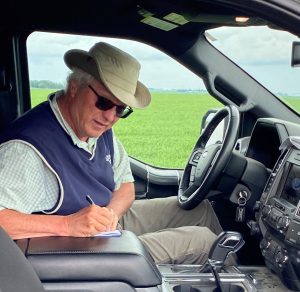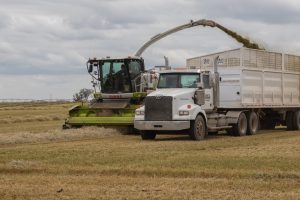Picture Butte Growing Project
While the sight of multiple combines harvesting a field is impressive, there is much work that is less visible to those who follow our growing projects.
A day with an agronomist
While the sight of multiple combines harvesting a field is impressive, there is much work that is less visible to those who follow our growing projects. George Lubberts is one of many agronomists throughout the province who provide behind-the-scenes support by donating their expertise to Canadian Foodgrains Bank growing projects.
Providing advice to help farmers keep their soil and crops healthy, people like George take soil samples, calculate fertilizer ratios, check soil water
Accompanying him on his weekly visit to the barley field of the Picture Butte Growing Project, I followed George checking soil water conditions, looking for signs of plant disease, and assessing the wild oats situation. All checks came out positive, and the future for this crop looks bright.
Let it grow, let it grow, let it grow!
Thanks to all of you who quietly donate your time and expertise to our growing projects.
– Ary Vreeken, Canadian Foodgrains Bank regional representative
Picture Butte Growing Project hailed out
It sounded a bit like a funeral announcement, my email read: “The Picture Butte barley field was harvested for silage today.”
What looked like a beautiful crop only weeks ago was destroyed in minutes by a devastating hailstorm. Members of the Picture Butte Growing Project had secured donations of inputs. But their challenge, this year, was to find land. When they finally did, they seeded it right away. Inputs were added, and rains came just in time. It looked so promising, until a day of violent hailstorms that hit the area.
On July 18, one massive hailstorm did what every farmer fears, and many experienced, that day: A hailstorm decimated a crop that looked so promising. Hail insurance, donated by Agriculture Financial Services Corporation (AFSC), will now be used to recover the costs of inputs.
Foodgrains Bank growing projects are not just supported by the growing project members who lead the initiative. They are supported by many individuals from the community who often quietly add value to the growing projects, even when things don’t work out as planned.
To recover some of the losses, the growing project found a local feedlot willing to purchase the crop as silage. This is a community project, so someone who supports the Canadian Foodgrains Bank stepped up and purchased the crop as silage.
Thank you to all who volunteered to plan, provided inputs, churches that held offerings for this project, and so many others in the community who supported this crop for the sake of ending hunger.
– Ary Vreeken, Canadian Foodgrains Bank regional representative

